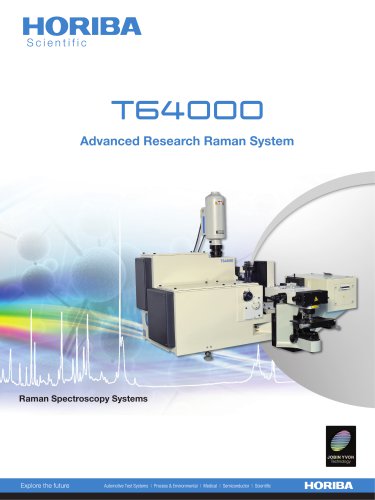 Website:
HORIBA Scientific
Website:
HORIBA Scientific
Group: HORIBA
Catalog excerpts
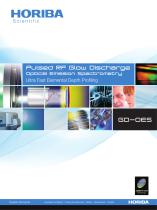
Pulsed RF Glow Discharge Optical Emission Spectrometry Ultra Fast Elemental Depth Profiling
Open the catalog to page 1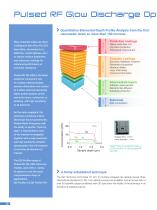
Pulsed RF Glow Discharge Op Quantitative Elemental Depth Profile Analysis from the first nanometer down to more than 150 microns 1-100 nm 10-1000 nm Protective coatings multilayered (thin films PV, LED, hard disks, electrodes for Li Native oxide (few nm) Corrosion protection Tribological improvement Structure: Multilayer, Gradient, Elemental composition Interface details Layer intermixing Compound formation Most materials today are either Adhesion improvement Element inter-diffusion Substrate protection batteries, coated glasses, etc.) or feature surface treatments Complex coatings and...
Open the catalog to page 2
tical Emission Spectrometry Speed & depth resolution With a typical erosion rate of µm/min (2-10 nm/s), researchers are encouraged to run multiple samples. The immediate feedback allows them to optimize and control each stage of their evaporation, deposition or annealing processes and to quickly react to any observed variation. Pulsed RF GD-OES offers superb depth resolution down to the nanometer scale or below, made possible by the unique characteristics of the advanced pulsed RF GD source and the Ultra Fast Detection capability of the optical system. Sub nm depth resolution Mirror for...
Open the catalog to page 3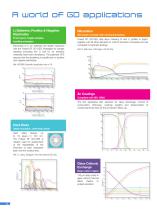
A world of GD applications Li Batteries: Positive & Negative Electrodes Thick layers, fragile samples, handling strategies Electrodes of Li ion batteries are readily measured with the Pulsed RF GD-OES. Strategies for sample handling (including the Li bell for air sensitive materials) have been developed. The patented UFS assures that the sputtering is equally fast on positive and negative electrodes. Ref: HORIBA Scientific Application note n°18 Nitruration GD results correlate with mechanical testing Pulsed RF GD-OES data allow following N and C profiles in depth, together with all other...
Open the catalog to page 4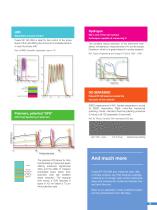
LED Deposition process control Pulsed RF GD-OES is ideal for fast control of the active layers of the LED offering the chance for immediate reaction in case of process drift. Ref: HORIBA Scientific Application note n°19 GD is one of the rare surface techniques capable of measuring H The excellent optical resolution of the instrument even allows simultaneous measurements of H, and its isotope Deuterium, which is of great interest for nuclear research. Ref: Fusion Engineering and Design 87 (2012) 1091– 1094 P-GaN InGaN/GaN Sapphire substrate Pulsed RF GD plasma reveals the structure of the...
Open the catalog to page 5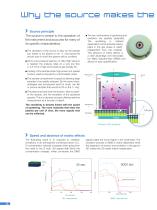
Why the source makes the Source principle The source is central to the operation of the instrument and accounts for many of its specific characteristics. T he two mechanisms of sputtering and excitation are spatially separated. The sputtering is material dependent, but the emission taking place in the gas phase is nearly independent from the material. This absence of matrix effects is a clear advantage over Secondary Ion Mass Spectrometry (SIMS) and allows for easy quantification. The operation of the source is easy as the sample just needs to be placed on an 'o’ ring facing the anodic tube...
Open the catalog to page 6
difference Unique source design The design of the HORIBA Scientific source has unique features that are essential for the advanced performance of the instruments. T he 13.56 MHz RF plasma gas ions involved in the sputtering process have low energy (50 eV) causing negligible surface damage. The source uses double pumping with 2 separated pumps. This assures a stable pressure repartition all over the sputtered area during the entire sputtering process. Without double pumping. Local pressure at surface is not uniform, resulting in poor sputtering. With double pumping. Sample grain structure is...
Open the catalog to page 7
Why light matters A confined plasma source The GD plasma is confined within the anode tube. 4 mm is the optimum anode diameter. Smaller anodes are available but they reduce the amount of light, and side walls effects become non-negligible. Larger anodes (up to 10 mm) could be used, but they do not provide optimum crater shapes. The optical design must therefore optimize the light collection. Direct observation (no fibers) and the use of the most luminous ion etched holographic diffraction gratings are therefore crucial for sensitivity. The HORIBA Scientific design is optimized for GD and...
Open the catalog to page 8
Flexibility: the true n+1 detection Even with the most complete line array, there could always be a need to measure an n+1 element for new research, to trace nano-particles added within a layer, to evaluate the impact of the addition of a minor element in the absorber layer of a PV cell on the efficiency of this cell, or to look at a new film deposit. The HORIBA Scientific answer to this need for flexibility is a direct coupled (no fiber) high resolution monochromator (C) with HDD detection. The monochromator could be added at any time without loss of light in the polychromator. Ni/Cu...
Open the catalog to page 9
A multidimensional platform f Software Multitasking and multilingual, Quantum software offers easy access to all the functionalities of the instrument (control of poly and mono operation, management of the patented PolyscanTM pulsed operation, etc.). Quantum can be used for data treatment on other computers in emulation mode while the instrument is making measurements. V 22 Overlay of measurements to study a varying process Powerful and flexible data handling with the unique functionalities of Time Plus (to increase analysis time during measurement), UFS (Ultra Fast Sputtering) to enhance...
Open the catalog to page 10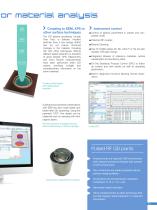
other surface techniques The GD plasma sputtering, though Ultra Fast, is delicate. Incident particles have a low energy (50eV) changes in the material. Coupling GD with other techniques offering different lateral resolution is therefore of great interest. XPS, Ellipsometry and micro Raman measurements have been performed within GD craters, providing multiple and same materials. with variable lateral Surface and cross section observations with SEM are also made easier and better after GD sputtering. Using the patented "UFS", fine details can be observed even on samples with thick organic...
Open the catalog to page 11All HORIBA Scientific catalogs and technical brochures
-
SLFA-60.6000
4 Pages
-
PX-375
6 Pages
-
XploRA Series Raman
8 Pages
-
LabRAM Odyssey - Pre booking
2 Pages
-
OMNI TERS Probes
2 Pages
-
NanoRaman
7 Pages
-
51 series
6 Pages
-
LabRAM HR Evolution
5 Pages
-
QPrep Automatic Dilutor
2 Pages
-
KiloArc
2 Pages
-
PowerArc
2 Pages
-
Laqua
24 Pages
-
Duetta
8 Pages
-
MacroRAM
2 Pages
-
PSA300
5 Pages
-
CAMSIZER XT
12 Pages
-
Particle Analyzer CAMSIZER
16 Pages
-
SZ-100
4 Pages
-
LA-960 Series - Partica
10 Pages
-
Plasma Profiling TOFMS
12 Pages
-
Nano-Spectroscopy Solutions
5 Pages
-
PTI QuantaMaster Series
20 Pages
-
SLFA-60/6000 series
4 Pages
-
XPLORER-TX/TS
6 Pages
-
XPLORER-NS
6 Pages
-
EMIA series
6 Pages
-
GD PROFILER
7 Pages
-
XGT-7200
2 Pages
-
XP Examina Forensics Package
4 Pages
-
Ultima Expert
5 Pages
-
XGT 1000WR Brochure
4 Pages
-
IRIS 4.2MP Scientific CMOS
2 Pages
-
iHR550 Imaging Spectrometer
4 Pages
-
FluoroMax Series
20 Pages
-
VS7000 PDA Brochure
2 Pages
-
VS7000 CCD HD Brochure
2 Pages
-
VS7000 CCD HS Brochure
2 Pages
-
Delta Time Brochure
8 Pages
-
Delta Series Brochure
12 Pages
-
FluoroMax-4 TCSPC
2 Pages
-
EMGA-921
4 Pages
-
EMGA-920
4 Pages
-
EMGA-930
4 Pages
-
EMIA-V2
14 Pages
-
VS-20
6 Pages
-
CLUE Series
6 Pages
-
Pulsed RF GD OES
7 Pages
-
Ultima Expert LT
3 Pages
-
LabSpec 6 Spectroscopy Suite
2 Pages
-
XploRA One
2 Pages
-
XploRA Series
5 Pages
-
Model H1034B
2 Pages
-
VS20
6 Pages
-
Ultima Expert
5 Pages
-
Sample Preparation
2 Pages
-
Forensics
2 Pages
-
Spectroscopy solutions
2 Pages
-
OpenPlex
2 Pages
-
AFM Raman
2 Pages
-
iHR Series Spectrometers
6 Pages
-
MESA-50
2 Pages
-
Dual-FL
7 Pages
-
Aqualog
6 Pages
-
Smart SE
2 Pages
Archived catalogs
-
SLFA-60 Brochure
2 Pages
-
JY 2000 2
2 Pages
-
ULTIMA 2
8 Pages
-
ICP-OES ACTIVA-M
12 Pages
-
ICCD
2 Pages
-
InGaAs Array
2 Pages
-
Compact Optical Chopper
1 Pages
-
Accessories for Spectroscopy
1 Pages
-
Symphony CCD Detectors
2 Pages
-
Glow Discharge OES
7 Pages























































































